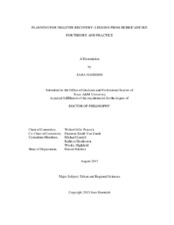| dc.description.abstract | Recovery is the least researched and prepared-for phase in the disaster management cycle, but the critique of the post-Katrina’s planning has begun to get researchers’ attention with an emerging consensus on the value of recovery planning and its timing. My dissertation focuses on improving recovery planning by asking “how can the recovery planning process and outcomes following Hurricane Ike in Galveston, Texas inform theories of recovery planning?” This inquiry is addressed in three articles.
The first article is an integrative review of the recovery planning literature, theories of planning and plan quality to lay out evaluation criteria. Recovery planning should be proactive, driven by local leadership, long-term and broad scope based on accurate data. Success of a recovery plan depends on setting transformative and restorative goals, alternative plausible futures and flexible policies. While federal recovery programs use several of these principles, they are criticized for short time frame, project-oriented and a prescriptive approach.
The second article undertakes a qualitative analysis of recovery planning in Galveston. Resistance to start planning early reflected a lack of capacity. Hence, when planning started, it was based on limited fact-basis and expertise. The planning process was open and transparent, yet not adequately representative; and deliberation on important issues fell short. The result was a list of projects, not a plan, which failed to gain political and legal approval.
The third study is an assessment of population, economic, and housing recovery. Population of Galveston is slowly restoring its pre-Ike level, but I found disparities among neighborhoods and race/ethnic sub-populations. Changes in shares of industries from job market and composition of jobs show that Ike was an interruption and acceleration to longer and broader trends in the local economy. Recovery of housing has either failed or been severely thwarted at the aggregate level. At the disaggregate level, the lag is even larger for damaged duplexes and multifamily units.
Finally, I synthesize the findings of the three studies and suggest lessons for recovery planning practice and questions for future research to further inform our knowledge of the opportunities and challenges in disaster recovery planning. | en |


